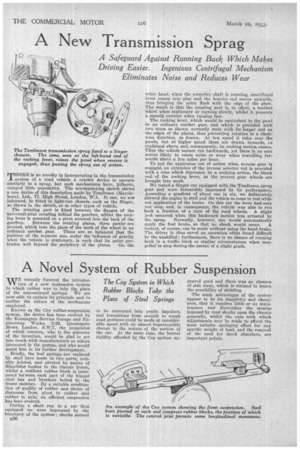A New Transmission Sprag
Page 54

If you've noticed an error in this article please click here to report it so we can fix it.
A Safeguard Against Running Back Which Makes Driving Easier. Ingenious Centrifugal Mechanism Eliminates Noise and Reduces Wear
MHERE is no novelty in incorporating in the transmission system of a road vehicle a ratchet device to operate similarly to a sprag, but such mechanisms have, hitherto, enjoyed little popularity. The accompanying sketch shows a new device of this description made by Tomlinson (Marylebone), Ltd., 77, High Street, London. W.1. It can, we are informed, be fitted to light-van chassis, such as the Singer, as shown in the sketch, or to other types of vehicle. The rotating part is fitted between the flanges of the universal-joint coupling behind the gearbox, whilst the rocking lever is mounted on a pivot screwed into the back of the
gearbox. Between the rotating plates, three pawls! are pivoted, which take the place of the teeth of the wheel in an
ordinary ratchet gear. These are so balanced that the position of the topmost one, under the influence of gravity when the vehicle is stationary, is such that its point pro trudes well beyond the periphery of the plates. On the other hand, when the propeller shaft is rotating, centrifugal force comes into play and the heavier end moves upwards, thus bringing the point flush with the edge of the plate. The result is that the rotating part is, in effect, a toothed wheel when stationary or turning slowly, whilst it presents a smooth exterior when turning fast.
The rocking lever, which would be equivalent to the pawl in an ordinary ratchet gear, and which is provided with two stops as shown, normally rests with its longer end on the edges of the plates, thus preventing rotation in a clockwise direction, as drawn. At low speed it rides over the pawls, but at higher speed these are drawn inwards, as explained above, and, consequently, its rocking motion ceases. Thus the vehicle cannot run backwards, yet there is no cam action likely to cause noise or wear when travelling forwards above a few miles per hour.
To put the apparatus out of action when reverse gear is engaged, an extension of the reverse selector rod is provided with a cone which depresses, by a wedging action, the blank end of the rocking lever, as the reverse gear wheels are brought into mesh.
We tested.a. Singer car equipped with the Tomlinson sprag gear and were favourably impressed by its performance. 4scending a gradient of about one in six, we deliberately allowed the engine to stall and the vehicle to come to rest without application of the brake. On this car the lever had only one stop, and, in consequence, the vehicle was able to run back a fraction of a turn of the road wheels. A slight jerk occurred when this backward motion was arrested by the sprag. Normally, however, one would automatically apply the foot brake, so that no shock would occur. A restart, of course' can be made without using the hand brake. The driver is thus saved an operation often found difficult by the unskilled ; furthermore, there is no chance of running back in a traffic block or similar circumstances when compelled to stop during the ascent of a slight grade.






































































































